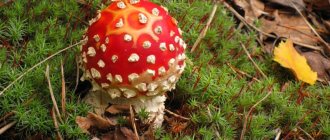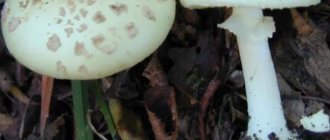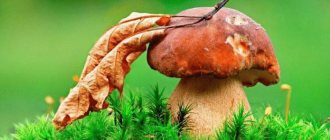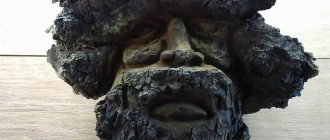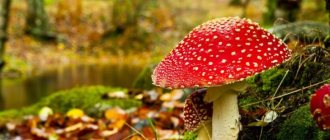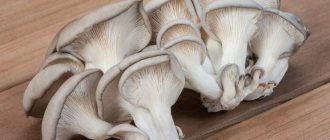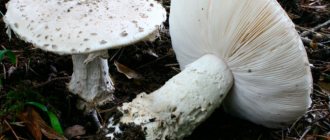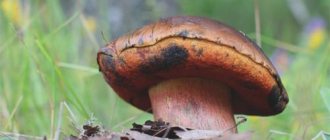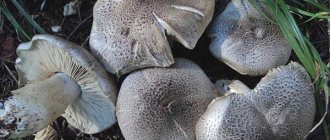Some, on the contrary, believe that fly agaric is an excellent remedy for some health problems. How is it really? Find out everything about the benefits and harmful properties of the mushroom, whether you can eat red fly agaric, how to properly prepare medicinal products based on it.
Description, composition, taxonomy and structural features of the fungus
Red fly agaric belongs to the poisonous psychoactive mushrooms of the genus Amanita, Family Agaricaceae, class Agaricomycetes. Latin name: Amanita muscaria.
The appearance of the name of the fungus is explained by its insecticidal properties against flies. It may be popularly called “old man”, “toadstool”, etc. The cost of dried mushroom in different countries reaches 150 euros.
hat
The size of this part of the fruiting body can grow between 8–20 cm. At first it has a hemispherical shape, then as the mushroom matures it opens and becomes flat and concave. It has a bright red tint (sometimes dark red). The skin is covered with white wart flakes of white color. There are flakes on the cap - remnants of the cover, which may fall off.
Hymenophore
This is what biologists call the lower part of the cap. The hymenophore is tubular, white in young hymenomycetes, yellowish in old ones.
Pulp on the cut
It is white in color and turns pale orange under the skin. When reacting with air, the shade of the pulp changes. The pulp is characterized by a slightly sweet taste and a subtle odor. The spores are smooth, ellipsoidal in shape, the spore powder is whitish in color.
Leg
This part varies from 5–20 cm in height, diameter – 1–2.5 cm. The shape is cylindrical, the base is thickened, the color is yellowish to white. As the fruiting body matures, the stem becomes hollow. In the upper part you can find a membranous ring with uneven edges and a brown surface.
At the moment, the red fly agaric does not belong to the lists of prohibited or legally controlled entheogenic mushrooms and plants, and is not included in the Red Book.
None of the hallucinogenic substances or their analogues contained in it are prosecuted for possession or distribution.
A little history
Scientists consider northeast Asia to be the homeland of the fly agaric (possibly Beringia, a landmass that arose several times on the site of the Bering Sea and connected Eurasia and North America). Date of birth - approximately 20 - 30 million years ago.
Albertus Magnus first mentioned this species in a scientific work in 1256, calling it “fly mushroom”, since the crushed fruiting body was actually used against these insects.
The type received its current name Amanita muscaria on January 1, 1821, thanks to the father of mycology, the Swedish naturalist Elias Magnus Fries. In the 20th century, these data were revised, the date was changed to May 1, 1753.
Important! It is believed that flies are repelled by the presence of ibotenic acid and muscimol in fly agaric; they die only from the smell of the mushroom pulp. This is not entirely true! In fact, these insects die after drinking water that accumulates in the mushroom cap (it absorbs alkaloids). Thus, the flies fall asleep under the influence of these substances and simply drown in the water.
Time and habitat
Habitat: coniferous, deciduous, mixed forests of the temperate climate of the Northern Hemisphere, especially common in birch or spruce forests with acidic soil.
Forms mycorrhizal symbiosis with almost any tree. Can be found next to redcaps, boletuses, chanterelles and other species.
Grows singly or in groups from June to mid-autumn. In Russia it grows almost everywhere. You don’t have to look for it for a long time; the mushroom can be found in any forest. The species is considered poisonous and is collected only for medicinal purposes.
What causes the red color of the fly agaric?
The bright orange, red color of the cap of this mushroom is explained by the presence of the substance muscaruphine in the fruiting body. It has antitumor and antibiotic properties.
In the red fly agaric it is not persistent, but in the North American Jackson's fly agaric it is so bright and stable that it is used by the aboriginal population to dye fabrics.
Effect of fly agaric when consumed
It must be remembered that there are a large number of fly agaric species and the consumption of some species can result in death. For example, the following types of fly agarics have not been studied or are deadly poisonous:
- Amanita phalloides - pale grebe;
- Amanita citrina - lemon fly agaric or yellow-pale toadstool;
- Amanita regalia - royal fly agaric;
- Amanita verna - spring fly agaric;
- Amanita virosa - stinking fly agaric.
In any case, if you accidentally ate an unknown mushroom, you must induce vomiting and go to the hospital urgently; if alkaloids begin to enter the blood, they can begin to destroy the liver and kidneys.
Growing at home and in the country
If there are no forests in your region, and fly agarics are needed to create medicines, then theoretically they can be grown. To do this, you need to collect spores in the forest and sow them in prepared soil. Growth will begin in a few years.
A brief process for growing fly agarics looks like this:
- First of all, it is worth considering that special conditions will be needed to grow these mushrooms. The fly agaric forms mycorrhiza with birch, spruce, aspen, oak and other deciduous and coniferous trees. Prepare the soil for sowing or purchase a special substrate.
- Inoculate the spores (mycelium) by moistening the soil with water. The required level of humidity of the mycelium must be constantly maintained for growth to be successful.
- Breeding fly agarics can take several years. Failures are also possible due to extreme temperatures, frosts, overflow or, conversely, the dry season. But this species demonstrates a high degree of adaptability to almost any living conditions.
When to collect fly agarics?
There are no clear dates for the start and end of the fly agaric collection season. Each year it can start at a different time, and it will depend on:
- From what kind of summer it is this year;
- From weather conditions;
- Depending on the type of fly agaric required.
If we talk about central Russia, the collection of fly agarics usually starts at the end of August and continues until the beginning of October. Fly agarics practically no longer grow in the fall, and therefore it can be quite difficult to find them.
Sometimes the season ends much earlier due to the fact that a small number of fly agaric mushrooms grow. For example, cases have been recorded when the collection of autumn fly agarics in early September, and the collection of fly agarics ended in October . Therefore, it is not written anywhere about when exactly it is necessary to go into the forest in search of poisonous specimens.
During the season, you can only collect fly agaric caps. It is important that they are darkish, round, smooth and have a large number of white inclusions. It is necessary to cut them off carefully and it is best to do this with gloves so as not to saturate the skin with poison and thus cause irritation.
As for further processing, it is necessary to cut the collected caps lengthwise and dry them for a long time. Many people are interested in how to store fly agarics ? Dried caps are stored in a closed, dark place inaccessible to children, best if it is dry.
False doubles
The red fly agaric is similar in appearance to its relative, the Caesar mushroom (Amanita caesarea), which is common in Southern Europe. But Caesar has a golden yellow leg and blades. Another relative, the pineal or cone-shaped fly agaric, is listed in the Red Book.
This distinctive feature can be easily identified from individual photos.
Classification, varieties and differences of dangerous doubles of the red fly agaric briefly:
| Name of the part of the mushroom | Amanita muscaria (red fly agaric) | Amanita pantherina (panther fly agaric) | Amanita rubescens (gray-pink fly agaric) |
| hat | Bright red, with characteristic white spots from scales. The edges are often jagged. | Olive-brown or olive, with white spots from large scales, there is a ring and a multi-layered volva on the leg. | Pinkish-brown cap with many gray or pinkish spots from large scales. |
| Hymenophore | The plates are loose, frequent, soft, initially white, later acquiring a yellowish color. Long ones alternate with short ones. | The plates are free, frequent, high. | The plates are loose, frequent, soft, white or cream in color. |
| Leg | At the base it has a significant thickening of up to 3 cm, without a volva, but with scales on the surface. | Gray-yellow, with a powdery coating. The stalk is thinned at the top and tuberous-widened near the base, with a white multilayered volva. There is a ring that disappears over time. | Gray-pink with a ring, with drooping edges and a thickening at the base, surrounded by the remains of a volva. |
| Pulp | White, then pale yellow, soft with an unpleasant odor. | Does not change color, white, watery, almost odorless and sweetish in taste. | White, turns pink or red over time. |
Where can I find fly agarics suitable for drying?
Even small children know this beautiful mushroom from pictures in children's books. Featuring a bright, shiny red hat with white raised dots and a pleated collar on the stem of a mature mushroom, this look is unmistakable. Fly agaric is found in almost all regions. Its bright red color makes the mushroom a literal bright spot on the landscape in many places. It prefers to grow in coniferous forests, often near spruce and birch. He lives in symbiosis with these trees. Like other so-called mycorrhizal fungi, these fruits colonize not only the soil, but also the roots of trees. Often fly agarics also grow in urban areas, such as parks or gardens. Fly agarics can be found from July to October.
What most people call a mushroom is actually a visible fruiting body. Spores released by the fruiting body are carried by the wind to new locations. Under suitable conditions, the spores germinate and new fungal colonies develop. A real mushroom lives in the soil and forms a dense network, the so-called mycelium, from which fruiting bodies appear. The mycelium consists of a fine-mesh network of individual fungal threads (hyphae) that grow through the top layer of soil. This happens most often in warm, humid places.
Eating and taste
It is known that the red fly agaric is poisonous, but you should not bypass this mushroom, much less destroy it. The famous Russian mycologist Mikhail Vishnevsky believes that there are 15 ways to eat this fruiting body: from raw to “fly agaric urine”.
If you eat red fly agaric raw, nothing bad will happen - it has a sweet, delicate taste. Pickling this non-edible mushroom is not recommended.
Boiling, frying, and other types of heat treatment have a detrimental effect on the toxic substances contained in the mushroom: ibotenic acid and muscimol. By first scraping the skin from the cap and periodically draining the water, these fruiting bodies are completely deprived of their psychotropic properties.
Fly agaric was used by some peoples of Europe and North America as a tonic food with restorative and psychedelic properties. In Japan, boiled and fried Amanita muscaria is also eaten without restrictions.
Interesting fact! The history of mankind does not know any fatal poisonings from fly agaric. It is estimated, for example, that in order to become poisoned, you will need to eat at least 20 large fly agaric mushrooms.
Variability
The red fly agaric can have different appearances depending on the location and growing conditions. The color of its cap can range from orange to deep red. In North America there is a mushroom with a yellow-orange cap. These are not different types of fly agarics, but only the result of the influence of environmental conditions and the place of growth.
Fly agaric with a yellow-orange cap.
When considering what these fruits are, it is necessary to take into account that the size, shape and color of the cap may vary depending on the age of the fruiting body. In older fruits, the color of the cap may become faded pink. If it rains constantly, pigmentation often disappears completely. In this case, the fly agaric becomes grayish-beige. This “faded” mushroom is no less dangerous. Any mushroom picker should know these facts about fly agaric so as not to confuse this fruit with edible species.
Medicinal properties and use in folk medicine
The mushroom cap, or more precisely, its upper red film, has the greatest medicinal value. Fly agaric contains strong poisonous alkaloids: muscarine, muscaredine, muscimol, ibotenic acid. Mushrooms contain a lot of fiber, as well as enzymes that promote the breakdown of fats and glycogen.
This type of fruiting bodies is very effective for oncological diseases (cancer, leukemia), radiation ulcers, and dermatitis.
In the pharmacological industry and homeopathy, medicines are made from mushroom extracts that help with angina pectoris with stabbing and burning pain in the heart, radiating to the left arm, palpitations, arrhythmia, angioneurosis of the extremities, and hernias.
In folk medicine, fly agaric is used to successfully treat diseases of the spinal cord, tics, chorea, alcoholism, alcoholic delirium, goiter, and depression. The tincture is used for external treatment of rheumatic pain, radiculitis, and gout.
Important information! Any treatment must be prescribed and accompanied by a doctor. Independent preparation and use of preparations based on any mushrooms is fraught with dangerous consequences and can have an extremely negative impact on health!
Taking vodka tincture
Fly agaric tincture is an excellent folk remedy against many ailments. It can treat ulcers, joint pain and even cancer.
How to cook:
- Extract juice from fresh fruiting bodies.
- Strain through several layers of gauze.
- Mix with alcohol or vodka in a 1:1 ratio.
- Pour the product into a dark glass container, close tightly and leave for 10 days.
The product is for external use only. The container should be shaken thoroughly before each use.
For internal use, a product is prepared based on a different recipe:
- Cut fly agaric mushrooms should be kept in the refrigerator for 1–2 days. Then finely chop and place in a glass jar.
- Pour in vodka or alcohol (70%), and the liquid should cover the contents of the jar by 2–4 cm.
- Leave for 2-3 weeks.
The product can be used for rubbing for rheumatism, radiculitis, osteochondrosis, problems with the spine and back. Taken orally in drops: 15-20 drops per dose as a sleeping pill, expectorant for coughs and pneumonia.
You can also make a homeopathic remedy from red fly agaric:
- Squeeze the juice from the mushrooms (2 drops), pour it with vodka (10 ml).
- Close the container with a lid and shake thoroughly.
- Measure out exactly 2 drops from this bottle and place in the same container with 10 ml of vodka. This procedure must be repeated 30 times, that is, dilute the initial dose 1:30.
The product is taken 5 drops per tablespoon of water 2 times a day, washed down with liquid. You should use the alcohol tincture for no longer than 3 weeks, then take a break for a week.
Dried red fly agaric
Drying red fly agaric helps convert toxic ibotenic acid into a less dangerous and psychoactive compound called muscimol. It is best to dry the fruiting bodies in their natural environment, strung on a thread or other convenient device (wire, thin rope).
Drying Features:
- Make sure that you are looking at Amanita Muscaria and not other relatives of this species.
- It is more advisable to dry the caps, since they contain the largest amount of active substances.
- Give preference to small, young specimens, leave old and lethargic ones in the forest.
- Dry until the fruit becomes brittle.
- After drying, the product should be stored in a dark, dry place.
Note! 10 g of properly prepared fly agarics corresponds to 110 g of fresh ones.
The effect of taking dried fly agaric depends on the dose taken and the individual characteristics of the person. The average norm is 15 g or 5 small caps, which are best taken gradually.
With a small dose, a person may experience increased energy, euphoria and mental clarity. In moderate cases, visual hallucinations appear, but nevertheless the person can react adequately and answer questions. With a large dose, a person becomes inadequate; vomiting, gastrointestinal upset, diarrhea, and increased secretion of saliva and sweat may occur.
Preparing the decoction
A decoction of fly agaric strengthens the immune system - the active substances of the mushroom force the body to produce antibodies that begin to fight not only mushroom toxins, but also other unwanted elements and parasites. The product helps expel helminths from the intestines and lamblia from the liver, is used for diarrhea, constipation, flatulence, and has a choleretic effect.
A decoction of red fly agaric is prepared as follows:
- Mushroom caps are placed in enamel or ceramic dishes and filled with water.
- You need to cook for about 10-15 minutes on low heat.
- Cool, strain the broth.
- Take 3 times a day after meals, 5-10 drops.
Red fly agaric ointment for radiculitis and arthritis
To prepare this folk remedy, take fresh mushroom caps and grind them with the same amount of sour cream or other fat (you can use badger). The mixture is thoroughly ground and applied to the sore spot at night. In the morning, wash it with warm water. Store the ointment in any container except metal.
Infused fly agaric juice for compresses
To prepare it, take the caps of fresh fruiting bodies and chop them. Fill the jar with this mass, close it, but so that air can enter the container (cover with gauze or make several holes in the nylon lid). In this form, the mushrooms should stand for a month. During this time, the fly agarics will give up their juice, which will remain at the bottom of the jar. It must be drained and used for its intended purpose.
For oncology
Cancer patients who have lost faith in healing often resort to treating the disease using folk remedies. This is extremely dangerous and is not recommended by doctors. However, drugs from fly agaric are taken externally and internally according to a special regimen, considering them a lesser evil compared to chemotherapy.
In addition, such folk remedies are considered good for preventing cancer.
The preparation algorithm consists of the following stages:
- Finely chopped caps of 4 mushrooms are placed in a glass container and filled with 150 ml of pure alcohol.
- Leave for 14 days in a dark place.
- After this time, the infusion is filtered.
Treatment is carried out according to the following scheme: start with 1-2 drops per day, increasing daily by 1-2 drops. The total volume is adjusted to 30–40 drops per dose. Such therapy can last a very long time, up to six months. Then the dose is reduced in the opposite direction, take a break and repeat again. When carrying out such treatment, you need to follow a diet: eat fermented milk products, vegetables, fruits, and drink a lot of water.
Red fly agaric tea
This drink has a pronounced hallucinogenic property; people begin to hear voices, see spirits, etc.
To make tea, you need to put 1 tsp in a glass of boiling water. mushroom powder and simmer for 15 minutes over medium heat. 3 minutes before the end of cooking, add 1 tea bag. At the end, you need to strain the broth and sweeten it to taste.
Use in cosmetology
The beneficial properties of red fly agaric are successfully used in cosmetology. Products based on this type successfully treat stretch marks, varicose veins, eczema and other problems. For example, anti-wrinkle cream promotes the synthesis of your own collagen. Mushroom oils supply valuable beneficial acids to cells.
Fact! In ancient Egypt, fly agaric ointment was used in cosmetology as a remedy for wrinkles.
Fly agaric extract in combination with citrus oil helps speed up metabolic processes in the deep layers of the skin. Massages with such oils perfectly relax and relieve inflammation in the muscles. Mushrooms also help with skin problems such as cracks and calluses - the cream softens the skin and speeds up healing.
Properties of fly agarics
One of the main properties is its negative impact on the human body and nervous system. The mushroom can cause hallucinations when consumed, and some types can cause a person to die. The fact is that representatives of the family contain the poison muscarine, which infects the body with toxic substances, penetrating inside.
As for the speed of spread of the poison, the process occurs quite quickly, and after 15 minutes the first symptoms can be noticed. They tell about all this even in childhood in order to protect curious children from the opportunity to try a poisonous mushroom.
Symptoms of mushroom poisoning, first and emergency aid
The red fly agaric contains a high content of toxic chemicals, which can cause poisoning:
- ibotenic acid and its derivative muscimol. Able to freely penetrate the blood-brain barrier to brain tissue. Act as psychomimetics (hallucinogens). Ibotenic acid - its crystallization occurs in anhydrous form or in the form of monohydrate; the substance is highly neurotoxic and causes the death of brain neurons.
- muscarine Causes a decrease in cardiac output and dilatation of blood vessels, a drop in blood pressure, nausea, vomiting, increased salivation, and bronchospasm.
- muscimol It is a psychoactive toxin, a mood stimulant, and has a dissociative, sedative-hypnotic effect. The molecular formula of muscimol is C4H6N2O2.
Fly agaric poisoning occurs rarely, but most often it is caused by improper use of products based on it for medicinal purposes. The first signs of intoxication begin to appear within a few hours after eating and carry a certain danger:
- weakness;
- nausea, vomiting;
- dizziness and headache;
- temperature increase;
- visual disturbances;
- bradycardia;
- delusions and hallucinations.
Death occurs extremely rarely, but the victim requires emergency medical care:
- Drink plenty of fluids before the doctors arrive (at least 1 liter).
- Inducing vomiting. The stomach should be lavaged until the vomit becomes clear.
- Taking absorbents: activated carbon, Enterosgel, Smecta, Polysorb. These drugs prevent the intestines from absorbing toxins.
From a toxicological point of view, atropine is an effective antidote for mushroom poisoning. The volume and advisability of taking it are determined only by a doctor. Self-medication for poisoning can be harmful to health.
Contraindications for use
Absolute contraindications for taking any drugs based on red fly agaric include pregnancy and breastfeeding, and others.
The consumption of this fruiting body by children is strictly prohibited.
When using products based on red fly agaric, you should take a particularly responsible approach to dosages, observe personal hygiene: wear gloves when working, wash your hands thoroughly with soap and water after touching the preparations. Make sure that toxic agents do not come into contact with mucous membranes, open wounds, or areas with affected skin.
Psychotropic and toxic properties of substances
The use of red fly agarics for food has long been practiced in the culture and life of many peoples. For example, the Chukchi took decoctions and powder of the mushroom as an intoxicating remedy and stored it in large quantities for the winter. After using these drugs, hallucinations arose, attacks of joy and anger alternated, objects split into two, sounds began to be heard, and colored visions appeared.
The state is similar to entering a trance; it was often used by shamans during rituals.
The ancient Hindus prepared the so-called sacred drink “soma” from the red fly agaric. In the descriptions we find the following description of the drink: “a child of the earth, red in color, without leaves, flowers or fruits, with a head resembling an eye,” which is quite consistent with the appearance of the fly agaric.
There is information that they could be prepared by the Yakuts, Yukaghirs and Ugrians. Moreover, in Western Siberia they ate fly agarics raw or drank a decoction of dried mushrooms and used them as a psychedelic. But most often they preferred to prepare mushrooms; they were dried, bitten off and washed down with water.
It is believed that during prolonged digestion the toxic properties of fly agaric are lost and it becomes less dangerous. But this opinion has not been scientifically confirmed so far.
Dried fly agarics
Fly agarics 30 gr
Dried red fly agaric caps Amanita Muscaria 30 grams of mushroom season 2022.
Mushrooms were dried using a special technology…
1,000 rub.
Fly agarics 50 gr
Dried red fly agaric caps Amanita Muscaria 50 grams of mushroom season 2022.
Mushrooms were dried using a special technology…
RUB 1,350
Fly agarics 100 gr
Dried red fly agaric caps Amanita Muscaria 100 grams of mushroom season 2022.
Mushrooms were dried using a special technology…
2,000 rub.
Fly agaric 150 gr
Caps of the red fly agaric Amanita Muscaria 150 grams of the mushroom season 2021.
Drying of the mushrooms was carried out using a special technology at the same temperature…
RUB 2,850
Fly agaric 200 gr
Dried red fly agaric caps Amanita Muscaria 200 grams of mushroom season 2022.
Mushrooms were dried using a special technology…
RUB 3,800
Unopened fly agaric caps 100 g
The composition of unopened caps contains the maximum amount of muscarine and muscimol and belongs to the first elite category of mushrooms.
Collection 2... 5,400 rub.
Not many people know where to find fly agarics , and constantly wonder where fly agarics grow . The answer to this question is quite simple - in the forest. It takes root in almost any forest, and you can even find fly agaric spots in Australia. If we talk about Russia, fly agarics are found among coniferous and deciduous trees. You can find it:
- In the tundra region;
- Among the birches;
- Among the firs.
A similar specimen of the apanitaceae family grows either alone or in whole groups.
Interesting facts and myths about fly agaric
- It is considered a deadly poisonous mushroom, but this is not entirely true. Experts say that it contains fewer toxins than toadstool. The lethal dose is 3–4 kilograms. For a person weighing 75 kilograms, one mushroom is needed to cause mild poisoning.
- In the troops of the Norman Vikings, there were berserkers - violently insane warriors with a frantic character, who rushed into the fray, sparing neither others nor themselves, not paying attention to their wounds. It is known that before the battle they ate fly agaric.
- Scientists have long refuted the relative insecticidal properties of this species, proving that flies die not from eating the fruiting body, but because they drown in the water accumulated in its cap. After the “drunk flies” were removed from the liquid, they woke up and flew away.
- The relative toxicity of fly agaric after several boils was successfully proven by mycologist Mikhail Vishnevsky, who suggests preparing these fruiting bodies fried.
- The Altaians proposed to include the red fly agaric in the Red Book, but this has not yet been done.
- Lovers of quiet hunting have a sign: if you find a black fly agaric, don’t expect anything good.
The red fly agaric is an amazingly beautiful representative of the mushroom kingdom! If you are not going to eat it or prepare medicinal potions from the fruiting body, or treat yourself with fly agaric, just leave it unharmed in the forest. Admire this beautiful creation of nature, it is worth decorating the world.
Information sources
1. Bulgakov K.G. Little-known edible mushrooms. - Moscow: Technosphere, 2012. 2. Bobyak, 1907. 3. Bukhalo, Mitropolskaya, 2001. 4. Identifier of mushrooms of Ukraine, 1979. 5. Red Book of the USSR, 1984 6. Sarkina et al., 2003.
Bioactive compounds contained in the red fly agaric A.Muscaria
Antioxidants
A. muscaria, like other mushrooms. of the genus, contain a huge number of biologically active compounds with proven antioxidant activity: proteins and peptides (glutathione and ergothioneine), phenolic compounds (flavonoids, lignans, oxidized polyphenols, phenolic acids, stilbenes and tannins), vitamins and derivatives (ascorbic acid, ergosterol , tocopherols, carotenoids) and minerals (zinc and selenium). Their antioxidant properties and free radical scavenging abilities have been further demonstrated in studies using rodent models of streptozotocin-induced liver injury. (STZ), carbon tetrachloride (CCl4) or D-galactosamine (D-GalN). For example, activation of the GABAA receptor suppresses stem cell proliferation but protects differentiated cells from damage (Wang et al., 2017). Muscimol treatment reduces the formation of pseudobile plastics and enlargement of hepatocyte channels in rats treated with GalN, revealing that a complex GABA signaling system exists in the rat liver. Its activation protects the liver from toxic effects. (Wang et al., 2017).
Pigments
The coloring of A. muscaria is due to a complex mixture of pigments. Muscaruphine and muscaflavine are terphenylquinone derivatives that give the yellow color.
The betalain group, consisting of large amounts of betalamic acid.
Condensates (muscapurpurine and muscaurines) with various amino acids, ibotenic acid or stizolobic acid are responsible for the typical red-orange color of the caps of A. muscaria (Michelot & Melendez-Howell, 2003). By repeated chromatography, the pigment mixture was separated into at least ten components, i.e. orange muscaurines, yellow muscaflavine, red-violet muscapurpurine and red muscarubrine (Stintzing et al. 2007).
Polysaccharides
Among the polysaccharides, the most common are glucans and widespread carbohydrates in the fungal cell wall. Fucomannogalactan (Ruthes et al. 2013) and (1 → 3), (1 → 6)-linked β-D-glucan (Kiho et al. 1994) were isolated from A. muscaria fruiting bodies and their biological activities were further studied against pain and inflammation, as well as antitumor effect. All these activities are the subject of further research.
For this reason, we recommend that fly agaric treatment be carried out with caution. Like other alkaloids, muscarine can be used as a stimulant only in small, non-toxic doses. In fact, muscarine does not cause a hallucinogenic effect; it is currently assumed that mycoatropine (mushroom atropine or muscaridine) acts on the brain, although no experiments have been conducted on humans with mycoatropine, and this is only a hypothesis. Currently, there is very little information on the use of fly agarics, as well as the effect of its individual components on humans, this area has been poorly studied, everything you do with fly agarics, including ingestion, remains at your own peril and risk.
Virulence
The danger of the red fly agaric is due to the high concentration of various poisons in its composition. When consumed, the parasympathetic nervous system is seriously affected. The chemical composition of the red fly agaric contains poisons such as:
- muscarine;
- choline;
- bufotenine and betaine (responsible for the hallucinogenic effect);
- putrescine;
- ibotenic acid (irritates mucous membranes).
A person only needs 5 grams of red fly agaric in its pure form to receive a lethal dose of a large number of toxic substances. In combination with alcohol, poisons act many times faster and affect organs in a very short time.
According to one theory, ibotenic acid, contained in red fly agarics, kills various insects. However, using it indoors with people and pets is extremely dangerous. During drying, the mushrooms release bufotenin and betan, which have a hallucinogenic effect. These substances can cause seizures.
Neurotransmitters
Fly agaric is not at all similar to psilocybin mushrooms; it works on a completely different principle.
Ibotenic acid itself is close to Glutamate and has an affinity for NMDA and its metabotropic receptors (11). This means it speeds up the brain.
In contrast, muscimol is a GABA-A receptor agonist (12, 13). Adds confidence and mood. Alcohol and benzodiazepines, by the way, also modulate and make this receptor more active. Muscimol is also a partial GABA-C receptor agonist (14). They are similar to each other (15).
alcohol and fly agaric
Muscimol can inhibit MAO, an enzyme that regulates the destruction of our favorite Dopamines, Phenylethylamines, Norepinephrines (16, 17), thereby increasing them. MAO inhibitors are used in the same way as antidepressants.
Here is an example of an old report of changes in activity after administration of muscimol (18). It is clear that this has been studied in animals, but the dynamics of change can be taken into account. It can be seen that there is a decrease in acetylcholinesterase, in addition to MAO, which destroys acetylcholine. Consequently, there will be more acetylcholine, clarity of thinking.
In short, fly agaric changes the balances in almost all major neurotransmitters. You will become more energetic and dynamic, with increased courage and a distorted but clear perception of the world, or you will be stupidly poisoned.)
Let's look at the effects in more detail!
Preparing to collect fly agarics
Before going into the forest, you should be well prepared. Collecting fly agarics is a hobby that does not require a lot of special equipment. Much more important is knowledge about the types of mushrooms and the rules for their subsequent processing.
It is worth taking care in advance of durable, closed and waterproof shoes to avoid injuring your feet: there may be several blackberry bushes, and the ground may be damp. A waterproof jacket or sunscreen is also not included. It is worth adapting to the weather and doing everything possible to avoid freezing, getting sunburned or getting wet.
If you are harvesting in the forest, you should wear clothing that covers your legs and arms. You should definitely take repellent for mosquitoes or other flying insects with you. You especially need to beware of ticks. You should not leave exposed areas of your body, and upon returning and before taking a shower, you should carefully examine your skin.
You should also prepare the correct container for the harvest. Wicker baskets or buckets work better. It is important to provide oxygen access to freshly collected fly agarics. Without air, even good mushrooms ferment and become unusable.
What to do if you couldn’t avoid poisoning?
The very first and necessary action is to empty the stomach of all contents. Drink at least a liter of water, induce a gag reflex in the familiar way (two fingers in your mouth). It is necessary to induce vomiting until the stomach is completely empty of food.
- Take a strong laxative.
- If you don’t have any suitable medications at hand, make an enema from a warm soapy solution (laundry or baby soap will do).
- You need to take any medications as directed by your doctors.
- A lethal dose of poison is contained in 3-4 fly agaric mushrooms.
- Despite the improvement in the condition, in any case you need to consult a doctor.
Useful tips for choosing
When using mushrooms yourself, you need to be able to choose them correctly:
- the most useful, as well as harmful, substances are contained in the cap - this part must be intact, untouched by insects;
- when drying the caps, the plates are removed from them and then strung on a thread;
- when using, it is important to follow the recipe and the exact proportions of all ingredients;
- People with a diseased digestive system should avoid use;
- When making ointments and other products, metal utensils and metal utensils should be avoided.
This product is contraindicated in any form for people with mental disorders and pregnant (nursing) mothers.
At the end of use, it is advisable to thoroughly wash your hands with detergents; ideally, it is better to prepare a tincture or ointment while wearing rubber gloves. Internal preparations from fly agarics can only be taken after consultation with a treating specialist and under his supervision. For children, except in rare cases, mushroom-based medicines are not used.
It should be remembered that just four eaten fly agaric caps are enough to become poisoned without a chance of survival. Such poisonings may be accompanied by suffocation, delirium, convulsions and respiratory paralysis.
A poisonous mushroom, such as the fly agaric, is a living example of the inconsistency that is so characteristic of any living creature on our planet. On the one hand, it is extremely dangerous, on the other hand, it is beautiful, just like its appearance, and brings obvious benefits in the treatment of humans. All that remains is to use this undeniable gift of nature with respect and caution.
0
0
Copy link
Who is the product suitable for?
Dried caps, tinctures or microdosing - mushrooms can be used in completely different forms, but the benefits of their use are the same. The products will help reduce stress and improve memory, which is ideal for an ordinary employee of a large company who constantly solves certain complex problems.
Fly agaric is also recommended for those who want:
- get rid of bad habits
- improve the quality of your work and creativity;
- increase concentration and attention;
- develop communication skills
- get rid of emotional disorders, depression.
But remember, fly agaric is not a panacea, not a cure for all adversities and troubles. Before using it, be sure to consult your doctor.
Comment
How to absolutely not dry fly agarics
Many mushroom pickers offer dried fly agarics for sale on various websites; some write how they dried them in the oven or in the shade on a string. You can’t dry fly agarics this way, because when drying fly agarics in a gas oven, they are exposed to high temperatures, and they also seem to be “cooked” on baking sheets or racks, juice comes out abundantly from them and fly agarics become flabby, after drying them they stick to the baking sheet and become like pancakes, but some manage to dry fly agaric mushrooms in ovens over low heat, frying them for days. To be honest, there is little useful in such fly agarics, or rather, there is nothing useful. Some dry them on a thread or thin rope, hanging them around the apartment or in the sun outside; such fly agarics will also not bring any positive effect, because the drying temperature is very low and such fly agarics will deteriorate. It is not recommended to hang fly agarics to dry in the sun, because all useful substances decompose under ultraviolet light.
Use in cosmetology
Fly agaric extracts used in pharmacology or cosmetology contain practically no toxins. On the contrary, they are rich in beneficial enzymes, polysaccharides and antioxidants with high bioactivity. Red fly agaric extract is beneficial for skin care. This product promotes the production of collagen and the regeneration of skin cells, makes it firm and elastic, smoothes out fine wrinkles, improves complexion by lightening age spots. In addition, creams containing fly agaric extract are useful for combating cellulite and stretch marks on the skin. By the way, creams containing the extract of these mushrooms will also help get rid of calluses and cracks on the skin of the feet.
